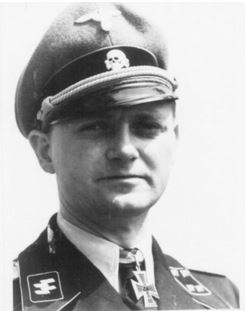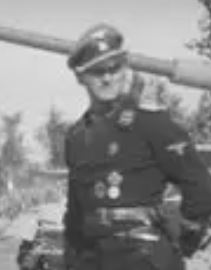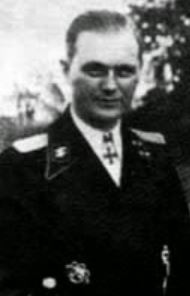Kuhlmann, Herbert (Waffen SS)
- Date of birth:
- April 7th, 1915 (Harburg, Germany)
- Date of death:
- November 9th, 1995 (Palermo Chico, Buenos Aires, Argentina)
- Service number:
- SS-Nr.: 118.826 // NSDAP-Nr.: 3.101.992
- Nationality:
- German (1933-1945, Third Reich)
Biography
Promotions:
01.08.1934: SS-Unterscharführer
20.04.1936: SS-Untersturmführer
30.01.1939: SS-Obersturmführer
20.04.1941: SS-Hauptsturmführer
21.06.1943: SS-Sturmbannführer
30.01.1945: SS-Obersturmbannführer
Career:
30.04.1933: joined the SS, SS-Standarte 'Germania'
24.04.1935-31.01.1936: SS-Junker, 2. SS-Führeranwärter-Lehrgang, SS-Junkerschule Braunschweig
00.00.1937: SS-Ustuf, Zugführer, SS-Regiment 'Germania', SS-VT - campaign in Austria and the Sudetes
00.09.1939: SS-Ostuf, Zugführer, SS-Regiment 'Germania', SS-VT - campaign in Poland
00.11.1939: SS-Ostuf, Zugführer, 2. Kompanie, SS-Aufklärungs-Abteilung 2, SS-Division 'Reich'
00.02.1940: SS-Ostuf, SS-Infanterie-Ersatz-Bataillon, SS-Standarte "Germania", SS-Division "Das Reich"
00.00.1940: SS-Ostuf, SS-Regiment 'Westland', SS-Division 'Wiking'
00.04.1941: SS-Hstuf, Chef, 2. Kompanie, SS-Infanterie-Regiment 'Nordland', SS-Division (mot) 'Wiking'
00.11.1941: WIA
01.01.1942: SS-Hstuf, SS-Infanterie-Ersatz-Bataillon
25.03.1942: SS-Hstuf, SS-Panzer-Aufklärungs-Abteilung 3
00.07.1942: SS-Hstuf, 1. Kompanie, SS-Panzer-Regiment 2, SS-Division 'Reich' (mot)
15.11.1942-00.12.1942: SS-Hstuf, Panzer-Kompanieführer-Lehrgang, Panzertruppenschule Wünsdorf
24.12.1942: SS-Hstuf, Chef, 2. Kompanie, SS-Panzer-Regiment 2, SS-Division 'Das Reich'
31.01.1943 or 08.02.1943: SS-Hstuf, Chef, 8. Kompanie, SS-Panzer-Regiment 2, SS-Division 'Das Reich'
10.02.1943 or 17.02.1943: SS-Stubaf, Führer, I. Abteilung, SS-Panzer-Regiment 2, 2. SS-Panzer-Division "Das Reich"
17.05.1943: SS-Stubaf, Stab, II. Armee-Korps
18.06.1943: transferred to the LSSAH
21.06.1943: SS-Stubaf, Führer, I. Abteilung, SS-Panzer-Regiment 1, 1. SS-Panzergrenadier-Division 'LSSAH' - Tcherkassy Pocket
23.01.1944: heart problems sent to SS-Lazarett Dachau
09.03.1944: heart failure
02.08.1944: SS-Stubaf, Kdr, SS-Panzer-Regiment 1, 1. SS-Panzergrenadier-Division 'LSSAH' - Operation 'Lüttich'
21.08.1944: severely WIA near Chambois, Falaise Pocket
00.11.1944: SS-Stubaf, Kdr, SS-Panzer-Regiment 12, 12. SS-Panzergrenadier-Regiment 'Hitlerjugend'
00.12.1944: SS-Stubaf, Führer, SS-Kampgruppe - Ardennes - Operation 'Stoesser'
00.00.1945: SS-Ostubaf, Kdr, SS-Panzer-Regiment 1, 1. SS-Panzer-Division 'LSSAH'
00.02.1945: Führer-Reserve, SS-Führungshauptamt
00.05.1945: US POW, Lagerältester, POW-camp Langwasser
00.00.1946: released moved to Argentina
Do you have more information about this person? Inform us!
- Period:
- Second World War (1939-1945)
- Rank:
- SS-Obersturmführer (Lieutenant)
- Awarded on:
- September 20th, 1939
- Period:
- Second World War (1939-1945)
- Rank:
- SS-Obersturmführer (Lieutenant)
- Awarded on:
- March 14th, 1941
- Period:
- Second World War (1939-1945)
- Awarded on:
- 1941
- Period:
- Second World War (1939-1945)
- Rank:
- SS-Hauptsturmführer (Captain)
- Awarded on:
- February 20th, 1942
- Period:
- Second World War (1939-1945)
- Rank:
- SS-Hauptsturmführer (Captain)
- Awarded on:
- October 20th, 1942
- Period:
- Second World War (1939-1945)
- Awarded on:
- 1942
- Period:
- Second World War (1939-1945)
- Awarded on:
- 1943
- Period:
- Second World War (1939-1945)
- Rank:
- SS-Sturmbannführer (Major)
- Awarded on:
- January 30th, 1944
- Period:
- Second World War (1939-1945)
- Rank:
- SS-Sturmbannführer (Major)
- Unit:
- Kommandeur, I. Abteilung, SS-Panzer-Regiment 1, 1. SS-Panzergrenadier-Division LSSAH
- Awarded on:
- February 13th, 1944
"SS-Sturmbannführer Kuhlmann has been the commander of the I. / (Heavy) Panzer-Regiment 1 LSSAH since the 06.11.1943, and with his battalion has always been close to all of the fighting that his battalion took part in, even if only a few tanks were ready for battle. In all these actions, SS-Sturmbannführer Kuhlmann has demonstrated excellent leadership characteristics and always led his troops from the front line.
I. During the attack on Komin (near Ssolowjewka) on the 15.11.1943, SS-Sturmbannführer Kuhlmann showed extraordinary alertness, fearlessness, and daring. While the infantry, supported by Sturmgeschütze, frontally attacked the village and found tough resistance he took the independent decision to launch a flanking maneuver far to the west and smashed the completely shocked enemy, throwing them from their positions and moving into Ssolowjewka from the northwest. This enveloping attack meant the enemy could not escape and a heavy tank battle took place into the twilight, during which 24 T-34s and 8 assault guns were shot up.
II. On the 01.23.1944, SS-Sturmbannführer Kuhlmann, as leader in the Panzer-Regiment subordinated to the 2. Panzergrenadier-Regiment and the II. Artillery Battalion, was in the area west of Turboff opening positions of the enemy and pushing through the positions of the 101. Jäger Division. From there, they immediately pushed on to the Bila sector and over Hill 316.5, 307.8 and the railway station at Lipowez, obtaining this and securing it.
SS-Sturmbannführer Kuhlmann has executed this assignment with the necessary speed, but also under extraordinarily difficult ground conditions and strong anti-tank plus heavy artillery and mortar fire. In doing so the enemy was completely caught off guard by this breach of the armored group. Thanks to the speed of the attack, seven Russian infantry divisions were trapped within the pocket.
After the village of Brizkoje they had to overcome extraordinary difficulties getting over the bridge and to the opposite side. The armored group pushed ahead to Hill 316.5 and shot up 12 T-34s and 4 assault guns, despite the strongest of flanking fire from Otscheretnia, the onset of a snowstorm, and increasing twilight. They broke into Ganowka and completely surprised the enemy, destroying them and throwing them from their positions.
Due to the extraordinarily difficult ground conditions (balkas and swamps) the village of Najadowka could only be taken frontally. Despite heavy flanking fire from Otscheretnia and a violent defense of Napatowka, the breach by the heavy armored group was achieved with rapid speed into the northern sector. They overwhelmed the enemy and drove them off, with the enemy responding by hastily retreating, leaving behind many weapons in their positions.
One bridge that was prepared for demolition was cleared of mines despite fierce bombardment. It was thus possible for the Kampfgruppe to attack Rossosche and also take the extremely important Hill 292.3. Since this still did not result in taking the place frontally due to the heaviest artillery and anti-tank defenses, SS-Sturmbannführer Kuhlmann ordered the tying down of the enemy by the Panzer IVs. He then sat at the head of his Panther group and circumnavigated the place, breaching it with a flank attack from the west. This was despite the worst visibility and having to halt at the bridge during the night attack in Rossosche. The enemy was also fully overwhelmed here through the surprise, comprehensive attack and left behind a lot of war materiel, including vehicles and tanks.
Due to a lack of fuel and ammunition the planned attack for the next day could not take place. The enemy, apparently aware of the supply situation of Gruppe Kuhlmann, began violent attacks against them. However, through the use of the tanks from Kampfgruppe Kuhlmann in tank defense positions situated around the whole place and with the infantry providing security for them, they managed to defend themselves for a whole day. They managed to repel strong tank and infantry units and shot up many tanks, often using their last rounds.
The enemy tried to take back the village of Rossosche twice during the night; both times they came up against the personal determination of SS-Sturmbannführer Kuhlmann. He repulsed them with his tanks, making them combat ready using the last reserves of fuel and ammunition.
On the 28.01.1944, Kampfgruppe Kuhlmann had fresh supplies and pushed over the railway line at Babin and farther towards Morosowka. This daring push led SS-Sturmbannführer Kuhlmann to once again completely surprise the enemy, who fled to the south through the forest while leaving behind significant war materiel. Over the course of this armoured attack from the 25.-29.01.1944 Kampfgruppe Kuhlmann captured or destroyed:
116 tanks
89 Heavy anti-tank guns
11 Guns (12.2 cm)
14 Tractors
250 Prisoners
trapped the bulk of 7 Infantry Divisions.
I believe SS-Sturmbannführer Kuhlmann, because of the outstanding leadership of his heavy Panther battalion during all of the combat days since the 06.11.1943, his personal courage and being a stirring role model, as well as the excellent execution of orders in the area southwest of Pogrebitsche, is worthy for the high award of the Knight's Cross of the Iron Cross. I please ask that you give him this award."
- Period:
- Second World War (1939-1945)
- Rank:
- SS-Sturmbannführer (Major)
- Unit:
- Kommandeur, I. Abteilung, (s.) SS-Panzer-Regiment 1, 1. SS-Panzergrenadier-Division LSSAH
- Awarded on:
- November 8th, 1944
Sources
- Photo 1:
- Photo 2:
- Photo 3:
- - MOONEY, PETER, Waffen-SS Knights and their Battles, Schiffer Military History, 2016.
- Die Ordensträger der Deutschen Wehrmacht
- Scheibert H., Die Träger des Deutschen Kreuzes in Gold (Kriegsmarine, Luftwaffe, Waffen-SS) und Deutschen Kreuzes in Silber (Heer, Kriegsmarine, Luftwaffe, Waffen-SS)























